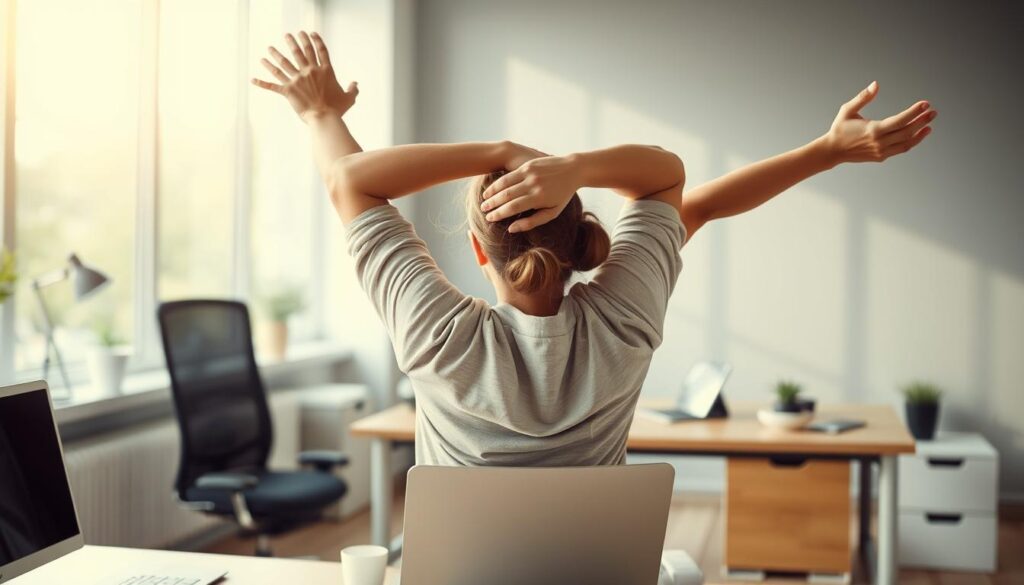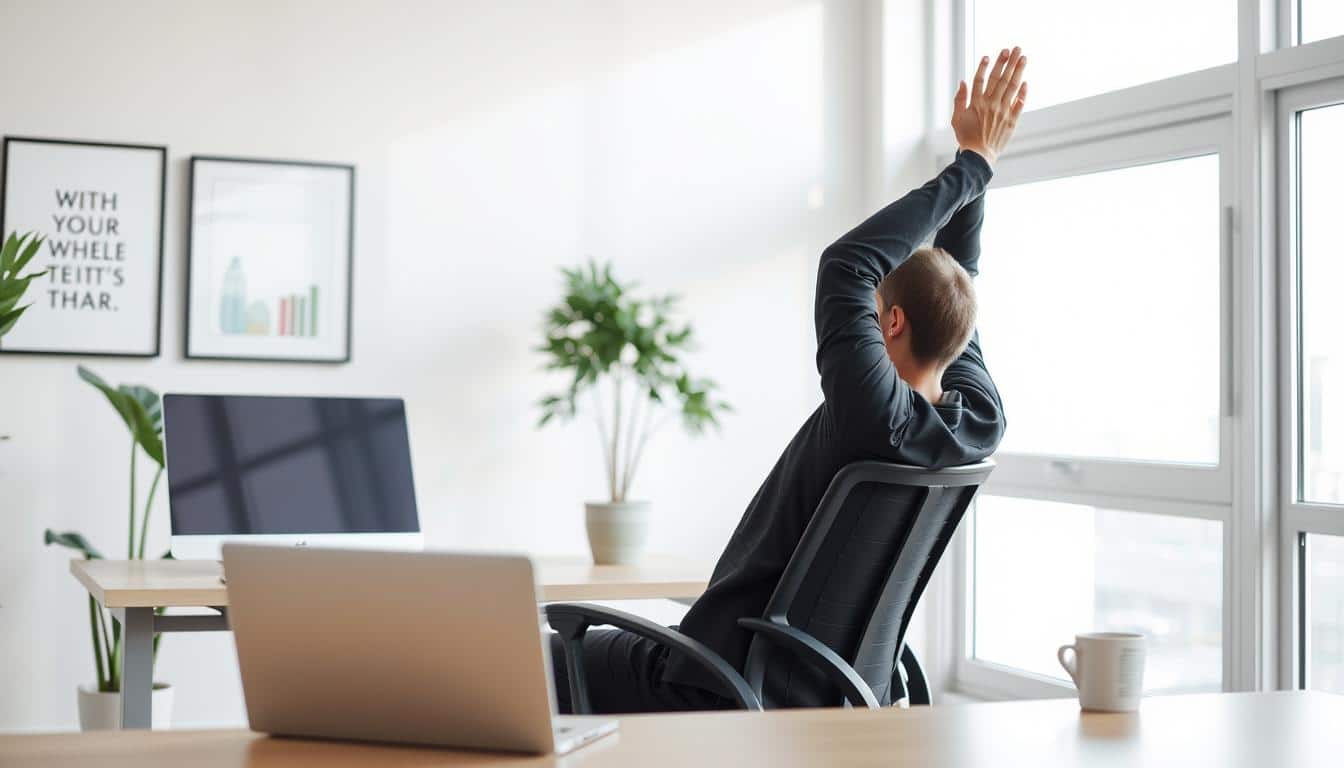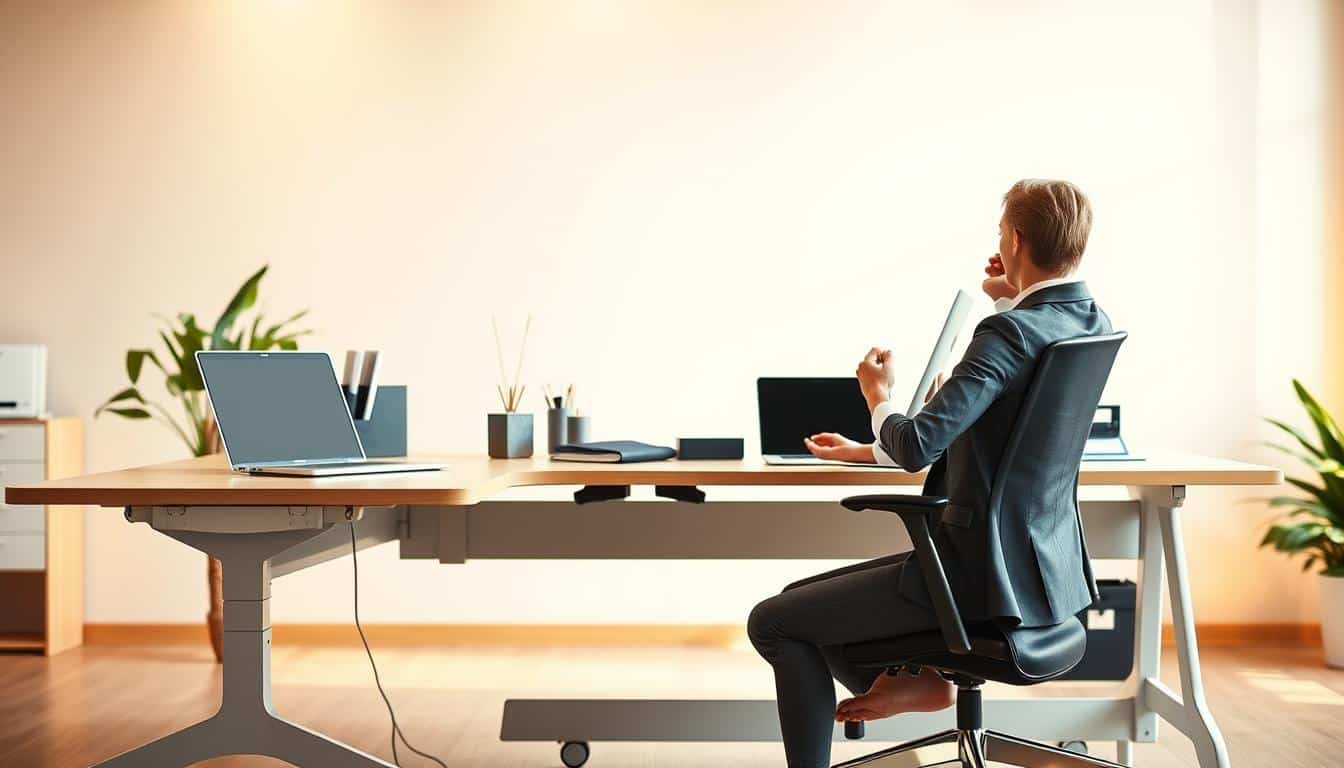In today’s fast-paced work environment, many of us are stuck sitting for long hours. This can cause a lot of physical discomfort and stress. Luckily, simple seated desk stretches can help relieve stress and improve our health at work. These easy stretches target your arms, torso, and legs, making you feel better while you work.
Just taking a few minutes to stretch during the day can ease pain and boost blood flow. This can make your work environment more comfortable. From a simple triceps stretch to twisting your torso, these movements refresh you. They make it easier to focus on your work. Let’s look at how these stretches can make your workday healthier and more fun.
Understanding Seated Desk Stresses
Many people work long hours sitting at desks, which causes health issues. Sitting too long causes neck, shoulder, and back problems. About 80% of American workers face these problems because of bad posture and doing the same movements over and over.
Sitting all day can lead to muscle tension, back pain, and less movement. It also increases the chance of getting spinal issues, carpal tunnel syndrome, and other health problems. If you sit more than three hours a day, you’re at risk for heart disease and diabetes. This risk is as bad as the risk from smoking.
It’s important to know the signs of discomfort from sitting too much. Understanding these stresses helps workers take steps to feel better. Doing simple stretches and moving around during the day can lessen pain and boost health.
Why Stretching is Essential for Office Workers
Stretching is very important for people who work in offices. Sitting for hours can make muscles stiff and uncomfortable, leading to health problems. Stretching helps ease this tension and makes you more flexible, which can improve how you sit and stand.
The typical office worker sits at a desk for about 1,700 hours every year. This lack of movement can cause back pain and bad posture. By stretching every day, you can fight these issues. Stretching gets your blood moving and relaxes your muscles.
Doing specific stretches helps parts of your body that get sore from sitting too much, like your shoulders, neck, and back. Moving these areas through shoulder shrugs and neck glides can lessen tightness and help your body work better. Taking short breaks to stretch every half hour keeps important muscles working well, which is good for your fitness at work.
Stretching is not only about fixing soreness. It also can make you feel more awake and think clearer, making you do better at your job. Remember to stretch the right way and listen to how your body feels to stay safe and get the most benefit.
Also, stretching in a relaxed way can make you feel less stressed and happier at work. Just 5 to 10 minutes of stretching every hour can greatly improve your physical and mental health, along with how well you do your job.
Effects of Prolonged Sitting on Your Health
Sitting for a long time has become a big problem in today’s work life. It leads to severe health issues apart from just feeling uncomfortable. Research has found a link between sitting a lot and serious conditions like obesity, heart diseases, and even some cancers. People who sit for more than eight hours a day without moving much face dangers similar to obesity and smoking.
Moving around regularly helps fight the bad effects of sitting too much. Studies show that doing moderate exercise for 60 to 75 minutes a day can reduce these risks. Even simple actions like standing up or walking around every 30 minutes can make a big difference. This not only helps your body but can also make you happier at work.
It’s important to include movement in your daily work life. Using a standing desk, having meetings on the go, and setting up your workspace right are key steps. Make sure your computer is at eye level to avoid neck pain, use armrests to relieve shoulder stress, and adjust your chair to support your back properly.
A 2017 study found that sitting for 6.5 hours a day led to more tiredness, high blood pressure, and body pain. This habit is linked to 6% of heart diseases, 10% of breast cancer, and 7% of diabetes cases. Ignoring the dangers of sitting too much hurts both people and their work places.
Seated Desk Stretches to Alleviate Discomfort
Adding seated desk stretches to your day can help ease discomfort and boost your work output. These stretches focus on areas like the arms, torso, and legs that get stiff. They improve blood flow and relieve the strain of sitting for long periods.
Stretching Out Your Arms
Stretching your arms relaxes tight muscles. For the One Arm Hug, pull one arm across your body and lightly push the elbow with your other arm. Hold this for 30 seconds, doing it 2-3 times on each arm. Then try the Seated Tricep Stretch by bending an arm behind your head and pushing the elbow back gently with the other hand. Keep this up for 30 seconds, repeating 3-5 times for each arm.
Don’t skip the Seated Lat Stretch which needs raising an arm, bending it across your body, and holding it with the other arm for 30 seconds.
Stretching Out Your Torso
For your torso, the Office Chair Back Stretch works well. Sit, reach behind to grasp your chair, arch your back, and push your chest out. Hold for 30 seconds and do it 5 times. The Seated Spine Twist is also good; cross your legs, twist towards the top leg, and hold for 30 seconds. Do this 3 times on each side.
Also, the Reach for the Sky stretch is beneficial. Interlock your hands and stretch them above your head to lengthen your spine. Do this for 10 seconds, five times.
Stretching Out Your Legs and Knees
Leg and knee stretches keep you mobile. For the Hamstring Chair Stretch, sit with legs straight and lean forward towards your toes. Hold for 30 seconds and repeat 3-5 times. Calf Raises help with calf strength. Stand and lift onto your toes 20 times. The Hip Stretch, where you cross one ankle over the opposite knee and lean forward, should be held for 15-30 seconds on each side. Including these leg stretches in your routine is key for comfort and good posture.

Incorporating Movement into Your Workday
Adding movement to your day can make you work better. Most adults sit for over 7 hours during work. To help, set reminders for breaks throughout the day. Using ergonomic furniture also helps by making you sit properly and feel less pain.
Setting Timers for Breaks
It’s important to remind yourself to take short breaks. Do this every 30 to 60 minutes. Here’s how:
- Use a phone reminder or an app to alert you when it’s time to move.
- Create a sticky note on your desk as a visual reminder to take breaks.
- Incorporate desk-friendly exercises during these breaks to maximize their benefits.
Utilizing an Ergonomic Setup
Making your workspace ergonomic is key for staying healthy at a desk. Consider these changes:
- Opt for standing desks or adjustable chairs to improve posture.
- Incorporate simple movements during your work, such as standing during phone calls or walking during meetings.
- Try exercises like calf raises, wall sits, or standing quad stretches during short breaks to boost energy levels.
Breathing Techniques for Stress Relief
Using good breathing techniques at work can really help with stress relief. They make the workplace better by making us feel calmer. For example, you can breathe in deeply through your nose, let your belly fill up, and then breathe out slowly. Doing this for 10-20 minutes can make you feel peaceful and relaxed.
Equal breathing is another helpful method. You breathe in and out slowly, counting to five each time. You can try to go up to ten counts for deeper calmness. There’s also progressive muscle relaxation. It involves deep breaths and relaxing different muscle groups, starting from your feet and moving upwards. This not only eases stress but also helps you focus better.
There are other techniques like belly breathing and 4x4x4 breathing. Belly breathing lets you fill your stomach with air deeply. The 4x4x4 method involves breathing in, holding your breath, and breathing out for four counts each. Lion’s breath is fun—it starts with a deep inhale and ends with a strong “HA” sound. Trying different breaths through each nostril can also bring balance.
Mindfulness and meditation improve focus by relaxing the mind. The 4-7-8 technique helps control stress by breathing in for four, holding for seven, and out for eight seconds. Bellows Breath can bring energy and can be done right at your desk with breaths and arm movements.
Using these techniques often can help with stress and anxiety. They create a healthier workplace. Today, nearly 30% of U.S. workers feel burned out often. These easy methods can make a big difference for them.
Simple Head and Neck Stretches
Doing simple head and neck stretches can make a big difference when you sit for long periods. These stretches help ease neck tension and make you feel more comfortable at work.
Here are some great stretches to make part of your day:
- Shrug the Shoulders: Inhale and lift your shoulders up towards your ears, then exhale and roll them back and down. Do this 10 times.
- Tilt from Side to Side: Lean your head towards one shoulder to stretch the other side of your neck. Hold it for 5-10 seconds on each side.
- Point the Chin to the Shoulder: With your hand, gently pull your chin towards one shoulder and hold for 5-10 seconds. Do it on both sides.
- Open the Shoulders and Chest: With hands behind your back, press the palms together, roll your shoulders back, and maybe tilt your chin up. This helps open your chest and shoulders.
- Side Neck Stretch: Put your hand on your head and gently pull it towards your shoulder while taking deep breaths. This stretch is good for the tight muscles on the side of your neck.
- Turtle Stretch: Move your chin down towards your chest to stretch the back of your neck. For a deeper stretch, you can also put your hands on your head while doing this.
Adding these stretches to your daily routine can help avoid stiffness. They keep your neck comfortable all day at work.
Conclusion
Integrating seated desk stretches into daily routines is crucial for workplace health. Sitting too much raises the risk of heart disease, diabetes, and back pain. Simple stretches can improve posture, increase blood flow, and ease discomfort, greatly benefiting overall health.
Exercises like desk push-ups, core twists, and calf raises don’t need special equipment. They’ve been shown to cut down neck pain and muscle tension. Regular stretching and moving lowers chronic disease risks and boosts energy during the day.
Taking steps to add seated desk stretches to your day is key for a healthier workplace. The American Heart Association suggests breaking up sitting with physical activity. This combats the downsides of sitting all day. Making these changes can better spinal health, lift mood, and make workdays more productive.



